Epistemic Status: exploratory. I am REALLY not an economist, I don’t even play one on TV.
You can call it by a lot of names. You can call it crony capitalism, the mixed economy, or corporatism. Cost disease is an aspect of the problem, as are rent-seeking, regulatory capture, and oligopoly.
If Scrooge McDuck’s downtown Duckburg apartment rises in price, and Scrooge’s net worth rises equally, but nothing else changes, the distribution of purchasing power is now more unequal — fewer people can afford that apartment. But nobody is richer in terms of actual material wealth, not even Scrooge. Scrooge is only “richer” on paper. The total material wealth of Duckburg hasn’t gone up at all.
I’m concerned that something very like this is happening to developed countries in real life. When many goods become more expensive without materially improving, the result is increased wealth inequality without increased material abundance.
The original robber barons (Raubritter) were medieval German landowners who charged illegal private tolls to anyone who crossed their stretch of the Rhine. Essentially, they profited by restricting access to goods, holding trade hostage, rather than producing anything. The claim is that people in developed countries today are getting sucked dry by this kind of artificial access-restriction behavior. A clear-cut example is closed-access academic journals, which many scientists have begun to boycott; the value in a journal is produced by the scholars who author, edit, and referee papers, while the online journal’s only contribution is its ability to restrict access to those papers.
Scott Alexander said it right:
LOOK, REALLY OUR MAIN PROBLEM IS THAT ALL THE MOST IMPORTANT THINGS COST TEN TIMES AS MUCH AS THEY USED TO FOR NO REASON, PLUS THEY SEEM TO BE GOING DOWN IN QUALITY, AND NOBODY KNOWS WHY, AND WE’RE MOSTLY JUST DESPERATELY FLAILING AROUND LOOKING FOR SOLUTIONS HERE.
Except that it’s pretty easy to see why. We have a lot of trolls sitting under bridges charging tolls to people who want to cross. Modern Raubritter can easily maintain a hard-to-refute image that they’re providing value, and so make it hard for anyone to coordinate to avoid them. It’s genuinely risky to unilaterally skip college, refuse to publish in closed-access journals, or leave an expensive city with a booming economy. You know you’re being charged a ton for some stuff you don’t want or need, but it’s hard to tell where exactly the waste is; it’s dissipated and concealed and difficult to disentangle. As 19th century businessman John Wanamaker said, “Half the money I spend on advertising is wasted; the problem is, I don’t know which half.”
But, for now, let’s try to get a factual picture of what’s actually going on.
Stagnant Commodity-Denominated Growth
GDP is supposed to be adjusted for inflation, but the calculation of the inflation rate is pretty political and might be misleading. What happens if you instead denominate in commodities?
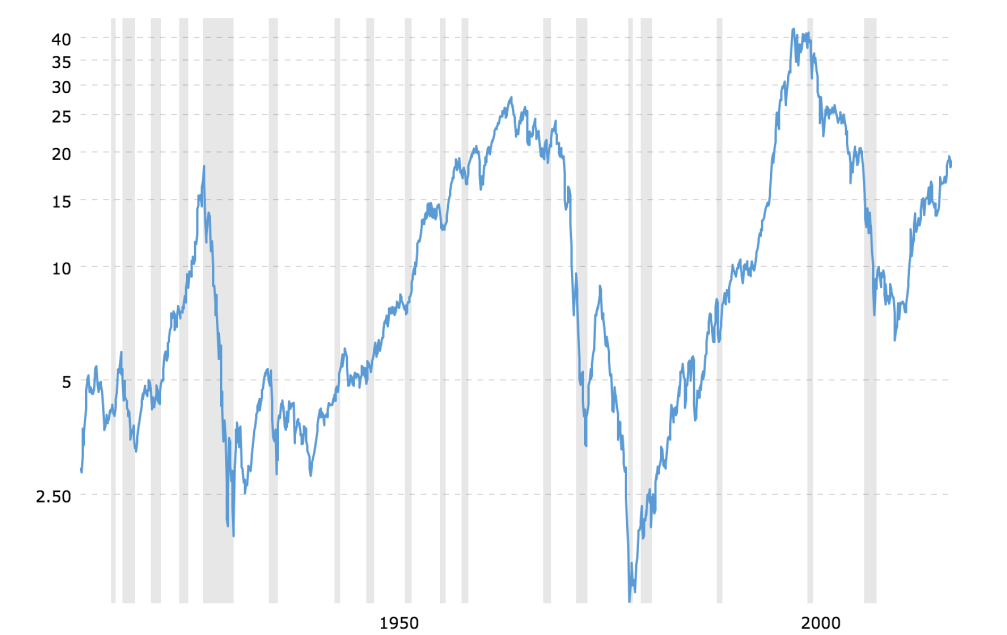
This is the Dow-to-gold ratio for the past 100 years; as you can see, there are three major contractions in the places you’d expect: one in the Great Depression, an even deeper one that began around 1972, and the most recent in the Great Recession that began in 2008.
You get a similar picture looking at the US GDP-to-gold ratio:

and the global GDP-to-gold ratio:
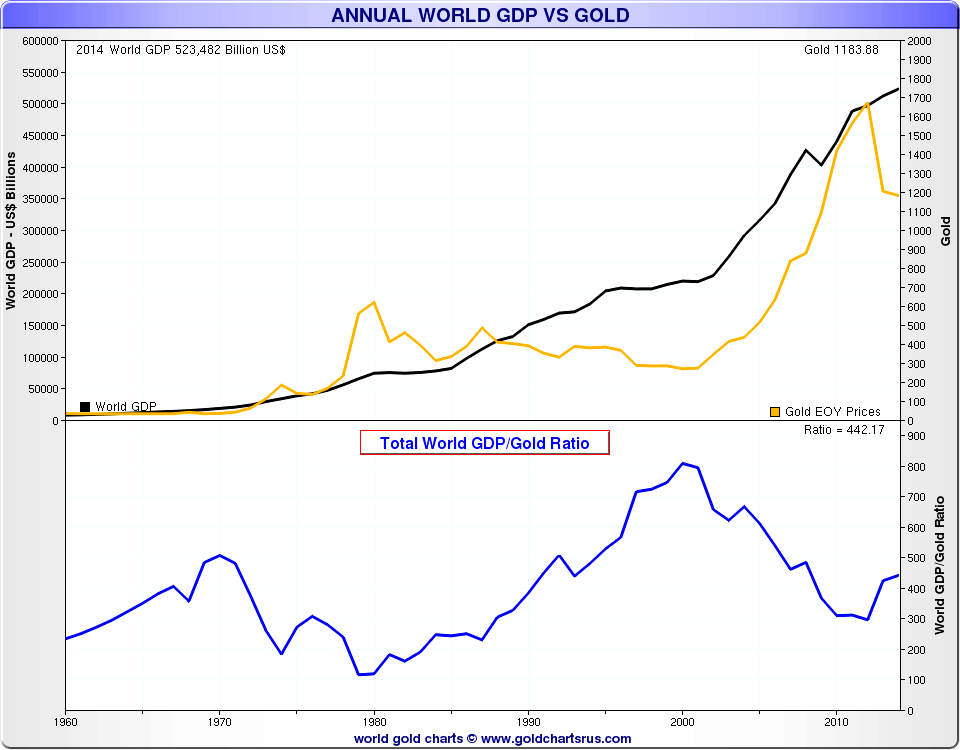
In 100 years we’re looking at something like an average of 1.4% growth in gold-denominated stocks or GDP; and gold-denominated GDP is comparable to where it was in the 1980’s.
But maybe that’s just gold. What about GDP denominated in other commodity prices? Here’s US GDP in terms of crude oil prices:
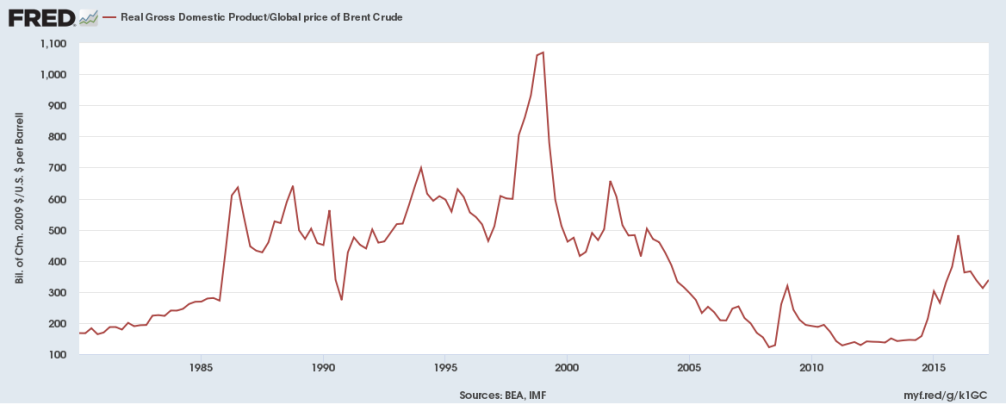
Once again, this shows US GDP never really recovering from the 2001 tech bust, and not being much higher than where it was in the 80’s.
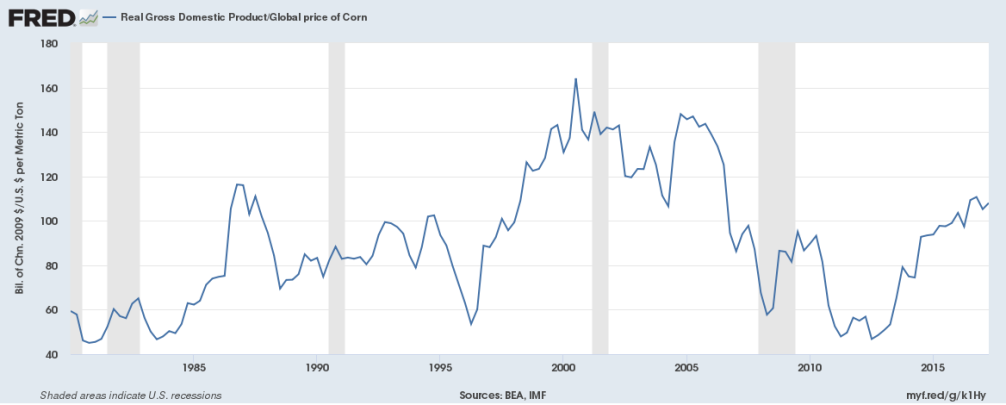
Compared to the global price of corn, again, US GDP barely seems to have an upward trend since 1980; something like 1.5% growth.
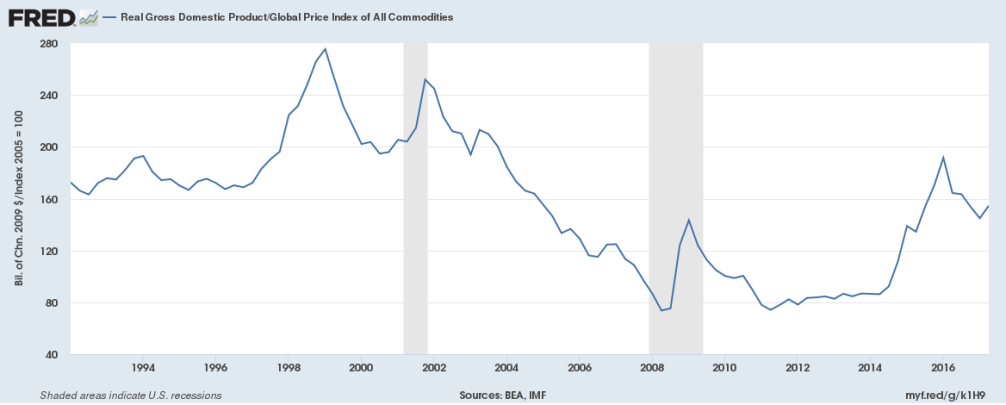
Compared to a global commodities index, once again, GDP seems no higher than it was in the 90’s.
This should make us somewhat suspicious that “real” GDP growth is overestimating growth in material wealth.
Of course, since median income has grown slower than GDP, this means that median income relative to commodities has actually dropped in recent decades.
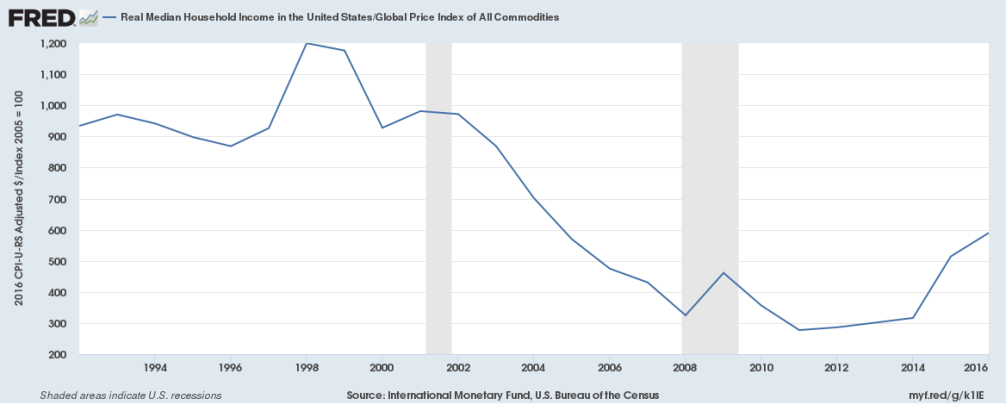
Stagnant Productivity
Labor productivity, in dollars per hour, has risen pretty steadily in advanced economies over the past half-century.
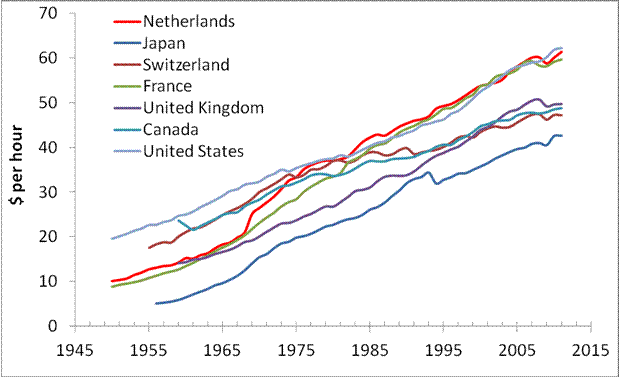
On the other hand, total factor productivity, the return on dollars of labor and capital, seems to have stagnated:
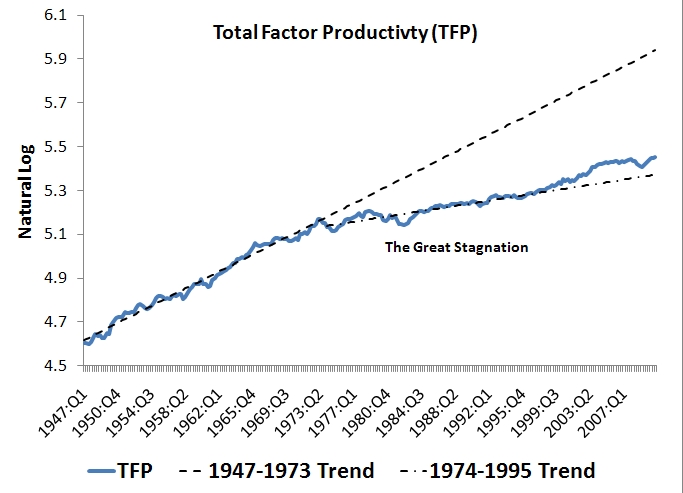
Total factor productivity is thought to include phenomena such as technological improvement, good institutions and governance, and culture. It’s been stagnating in other developed countries, not just the US:

A Brookings Institute report broke down US total factor productivity by sector, and concluded that the declining growth from 1987 to today was in services and construction, while manufacturing and other sectors continued to improve:
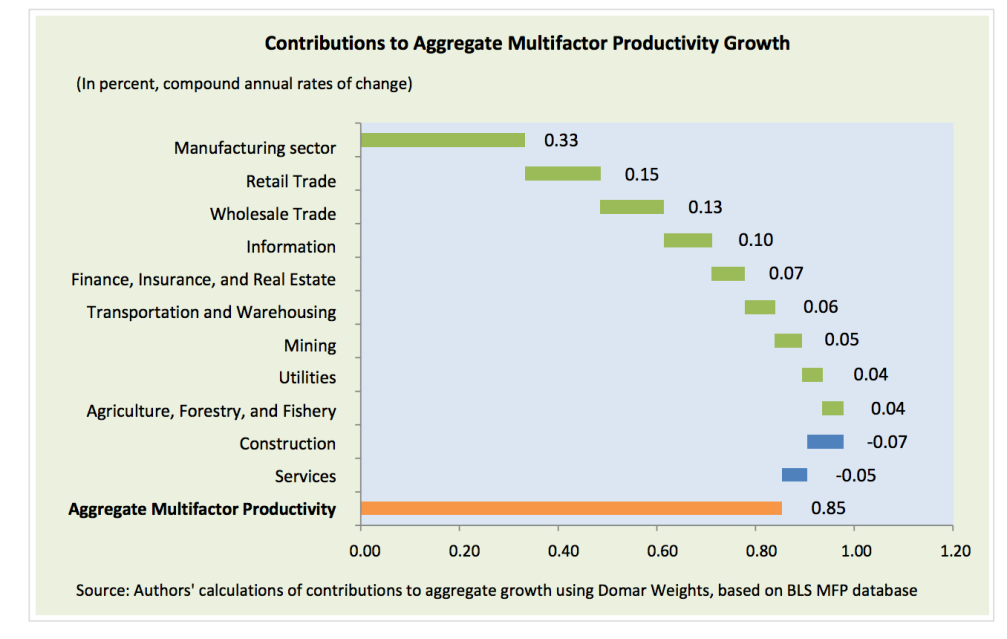
Services and construction, please note, pretty much match the “cost disease” sectors whose prices are rising faster than the rest of the economy can grow: education, housing, transportation, and especially healthcare. As services become more expensive, they’re also becoming less efficient.
Declining productivity means that we’re doing less with more. This is particularly true for innovation, where, for instance, we’re not getting much increase in crop yields despite huge increases in the number of agricultural researchers, and not getting much increase in lives saved despite increasing volume of medical research.


Monopoly and Declining Dynamism
The Herfindahl Index is a measure of market concentration, defined by the sum of the squares of the market shares of firms in an industry. (If a single firm held a monopoly it would be 1; if N firms each had equal shares, it would be 1/N.)
US industries have become more concentrated since the mid-1990s, with the number of firms dropping and the Herfindahl index rising:
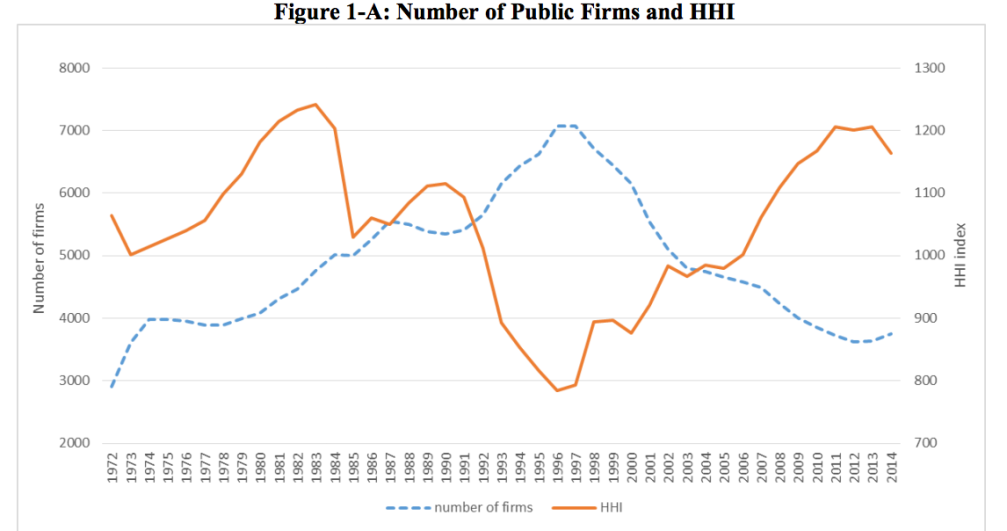
Firms have also gotten larger:
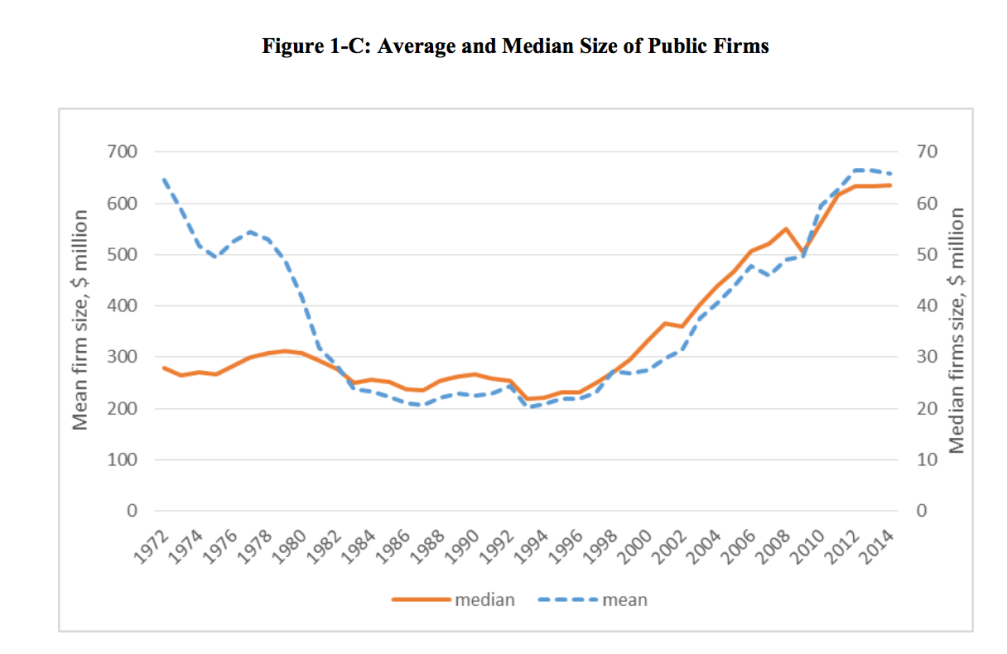
You can also look at concentration in terms of employment. Education and healthcare are the most concentrated industries by occupation, while computers are the least:
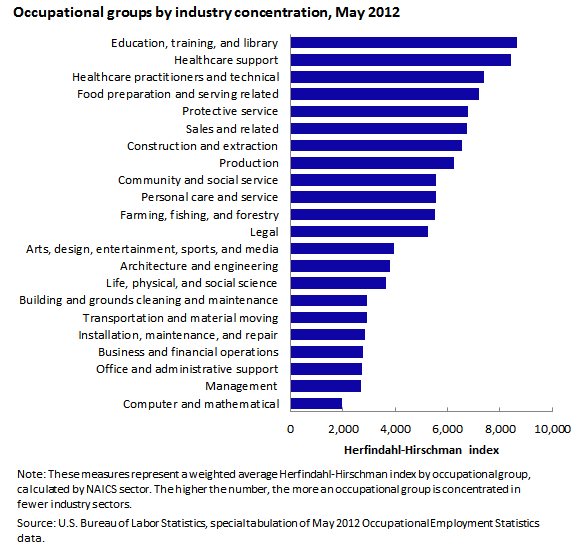
There has been a steady increase in market power since 1980, with markups rising from 18% above cost in 1980 to 67% above cost in 2014.
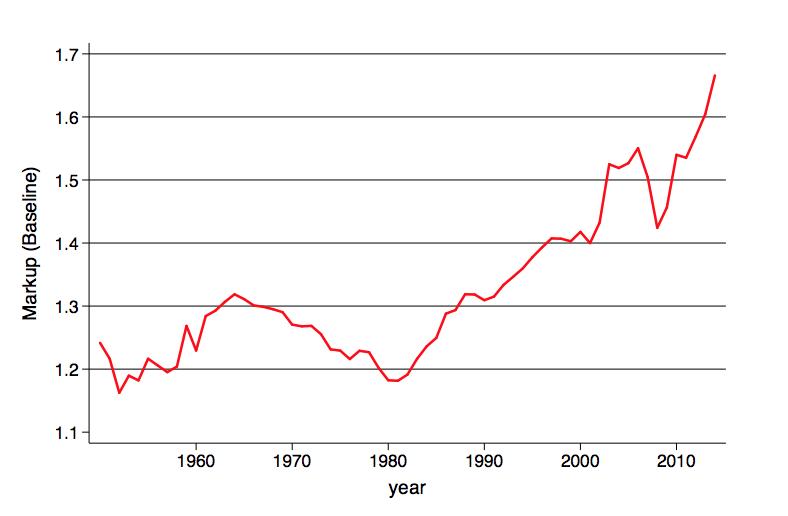
More concentrated industries can charge higher prices relative to costs.
As industries are becoming more concentrated, they’re also becoming more static. Fewer new firms are being created:
.jpg?1416512353)
Americans are moving less between states:
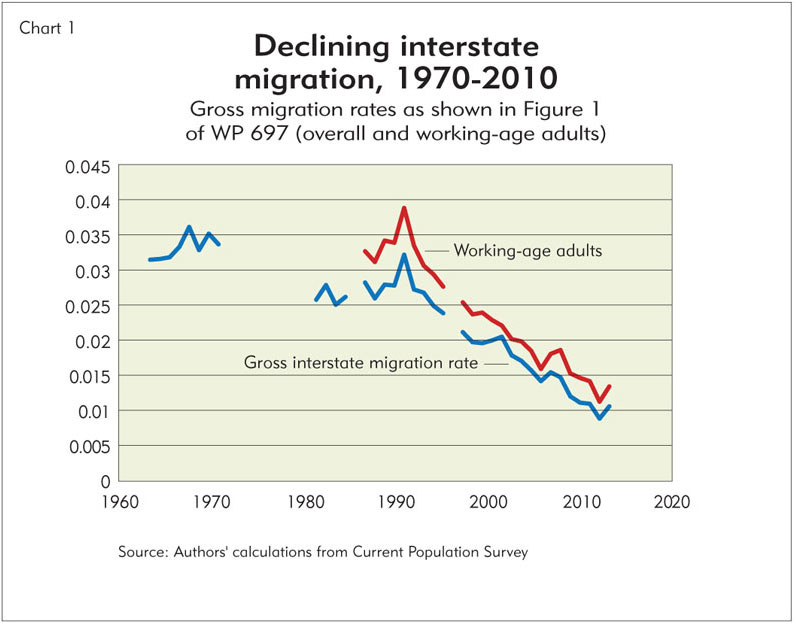
And self-employment is dropping:
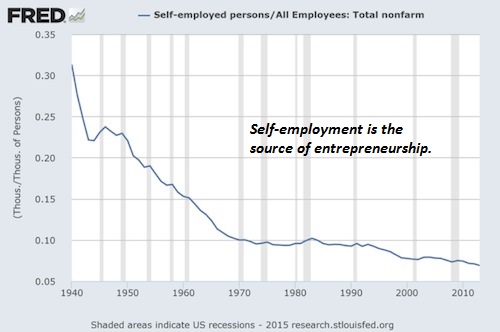
As market power increases (i.e. as industries become more monopolistic), you can get a scenario where the financial value of firms outpaces their investment in capital or their spending on labor.

With an increase in market power, the share of income consisting of pure rents increases, while the labor and capital shares both decrease. Finally, the greater monopoly power of firms leads them to restrict output. In restricting their output, firms decrease their investment in productive capital, even in spite of low interest rates.
If you divide the economy into “capital” and “labor”, you find a long-term decline in the share of labor and increase in the share of capital. But if you decompose the capital share, you find that the returns on structures, land, and equipment are static or declining, while pure profits are on an upward trajectory:
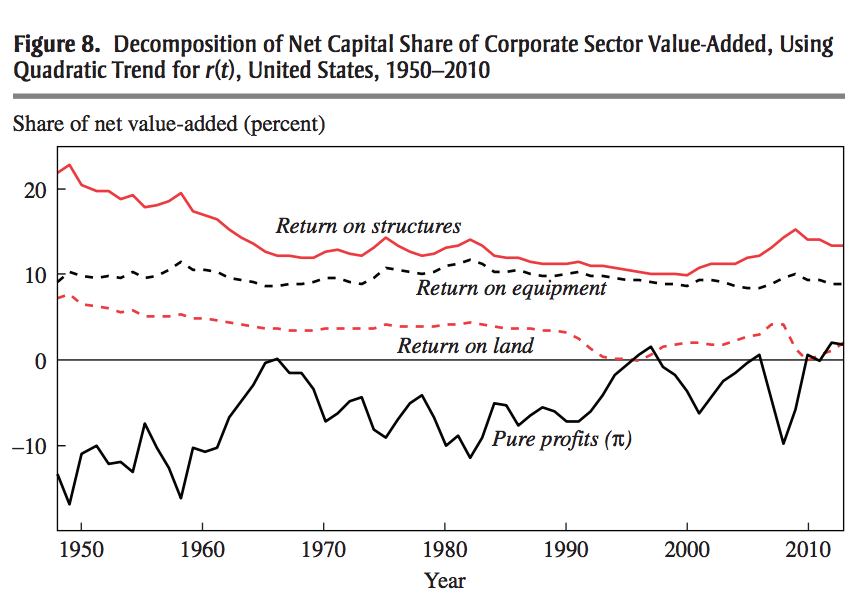
This story is consistent with other long-term trends, like the increasing share of the value of firms that consists of intangibles — that is, “the value of things you couldn’t easily copy, like patents, customer goodwill, employee goodwill, regulator favoritism, and hard to see features of company methods and culture.

Those intangibles constitute barriers to entry, precisely because they can’t be easily copied by new firms. The rise of intangibles is also a sign of a more monopolistic economy.
It’s Not (Just) Regulation
Alex Tabarrok, a libertarian economist, argues that the decline in dynamism is not due to regulation.
Since the 1970’s, the most stringently regulated industry by far has been manufacturing:

(“FIRE” here refers to finance, insurance, and real estate.)
However, more stringently regulated industries are not less dynamic:

Some of these results are weird, since #622, marked as a lightly regulated industry, is “Hospitals”, which I don’t really think of as freewheeling. Maybe these numbers don’t include indirect effects like occupational licensing for medical professionals restricting the supply of people to work in hospitals.
But at any rate, regulations are not the only way to enforce monopoly power, and it seems that they’re not the decisive factor. Governments have means other than regulation to promote monopoly (for instance, grants, contracts, or subsidies to insider firms, or increases in the scope of what can be patented and for how long). And there are purely private mechanisms (like prestige/signaling in the scientific publishing industry) that can preserve monopolies as well.
Problems for the Middle and Lower Classes
US income inequality is rising; in real dollar terms, this looks like the rich getting richer while everyone else stays the same:

On the other hand, it’s worth moderating this picture by awareness of cost disease. High-income people as well as lower-income people are spending a larger fraction of their budget on housing and healthcare, which aren’t really improving much in quality.

Income mobility is also dropping:

Some Slogans
Why is monopoly bad?
Monopoly drives up prices while depressing production. That means we have fewer nice things. Yes, even for the “winners” of this negative-sum game, though of course the problem is worse for everyone else.
Monopoly and lack of innovation go together, since monopolists have less incentive to produce or compete.
Monopoly and intangibles go together. Branding is a form of market power. As are patents.
Monopoly causes inequality; it also causes absolute economic insecurity (if necessities cost more, the poor are most harmed).
Monopoly is anti-meritocratic. It’s a troll guarding a bridge, not a hardworking genius inventor.
None of this tells us what to do about monopoly. I’m not at all confident that antitrust law works or is a fair solution to the problem. There’s also reason to doubt that deregulation would fix everything, though fixing zoning and occupational licensing laws seems like it would at least help.

Have not finished reading yet, but as someone who actually is economically trained and who works in finance, I ran into a few things that I couldn’t not comment on immediately upon seeing. You might regard them as triggers to economists.
First, the Dow is a terrible stock index, its constructed poorly, had too small a sample, and on top of that the weighting is calculated incorrectly. If you are going to quote a US stock index it should pretty much always be the S&P 500. Two, gold is a terrible commodity because its not particularly useful. The price of gold is largely determined by psychological factors rather than real factors. Better commodities to use might have been oil, steal, or soybeans which all have significant real world uses and have values determined by interactions with the real economy. Alternatively, Jim Rogers maintains a comprehensive cross commodity index, although I don’t know if that is available retroactively before he created the index (which I remember as being in the late 90s, but my timing could be off). The point about the Dow is, I think, so uncontroversial to the point that you should distrust anyone who disagrees with it. The point about gold is, I think, fairly mainstream among anyone not selling gold or sitting on lots of gold that they may want to unload on a greater fool at a later time.
Moving on to areas where reasonable people can (and frequently do) disagree. There are lots of credible measures of inflation and they all produce fairly close results. Kooky conspiracy types always say the government is hiding inflation, but independent measures get similar results. MIT runs a parallel non-governmental index called the billion price index that uses a much wider sampling than the government measures, so if you don’t like the gov’s methodology you could use that. Honestly though, the most credible critiques of inflation measurement that I am aware of tend to indicate that it is overstated rather than understated. The Boskin Commission did a good deep dive on this back in the 90s and honestly I think a lot of their points are only more true today. Inflation measures just don’t do a good job of reflecting quality improvements driven by technological improvement. When I was a kid $10 a month bought me one album (I’m not disclosing if that’s a record, cassette tape, or CD) a month. Now $10 a month buys me all the music in the entire history of humanity. On a per record price, that’s a change from $10 to rounds to $0, or massive deflation. Or look at price per floppy disk worth of data storage. Reflecting technological change is hard, but the upshot is, in my view, that we should be inclined to view inflation measures as having an upward bias rather than a downward bias.
And, lol at myself, I just read literally the next page. See kids, this is why you shouldn’t comment as soon as you see an objectionable point, no matte how objectionable it is.
But seriously, start with the all commodities index rather than with gold.
I’m sorry, but I see no serious reason to treat economic consensus as a real thing. I would be happy to ask you what particular economists say, but the Innovation and Education Industry is, as noted, concentrated and its product is of declining quality.
I think you need to use a different GDP series in the denominator for all your FRED graphs. “Real Gross Domestic Product” (GDPC1) is already inflation-adjusted using the GDP Deflator. So dividing it by any nominal price or nominal index double counts inflation. Instead you could try using the GDP or GDPA series which are based on nominal GDP. I’ve redone the corn chart that way ( https://fred.stlouisfed.org/series/GDPA#0 ) and the global price index of commodities ( https://fred.stlouisfed.org/graph/?g=k2tX ).
Note that your data is US GDP/world prices, which seems like a confounder of its own.
Why say that monopoly is the problem, rather than rent-seeking being the problem and monopoly a potentially important driver of the problem? It may even be the most important driver; but not all monopolies drive rent-seeking equally, and monopoly in the sense of industry concentration is not the only potential driver of rent-seeking (for example, as you note, the guild effect of occupational licensing isn’t likely to be captured in industrial concentration measures).
You’re probably right, rent-seeking is more core to what I object to than monopoly.
I’d be more cautious about intangibles. It’s a mystery and I see so many people filling in the details however they want. You don’t say much about it, so this is really just a nitpick, but I have to get it off of my chest.
Intangibles are a bigger part of the market value of companies, but that doesn’t mean that they are more important than they used to be. It might just be that the market values them better. Isn’t that what Warren Buffett did, identify companies intangibly well-run with intangible branding and bid them up? And Michael Milken, the opposite? That made Buffett rich, but it didn’t necessarily change the world, because this diversity already existed. It provided incentives for companies to create profitable intangibles. That could be a large effect, but this isn’t the way to measure it.
And what are these intangibles?
You linked to Robin Hanson, but he considers the branding hypothesis and rejects it, saying that brand loyalty is lower today.
If it’s competent management, that’s probably a good thing. Sure, that’s technically a competitive moat, but it’s hard to complain about.
Or maybe it’s something terrible, like a patent moat. I don’t know.
(In the comments at OB, Brendan says that Home Depot has a larger percentage intangibles than Apple and Google.)
Well said. It’s difficult to measure trust or company culture, or even the value of patents.
Maybe this is a call for patent reform because although it is a intangible that’s not just pure rent, since presumably R&D does on margins produce them, the vast majority of patents have relatively very little marginal cost in its production compared the current marginal ones.
This is very much the case with oil prices. http://graphics.wsj.com/oil-barrel-breakdown/
Some, but not all, of the rise of intangibles is simply rising levels of debt, leverage. Debt is a negative tangible asset. Some companies have negative net tangible assets! If a company issues debt, that doesn’t change its tangible assets, because the debt is canceled by the cash. But if it returns the cash as dividends, then it has reduced its tangible assets. Its market cap is reduced, but now is a more pure measure of its “enterprise valuation,” but without the enterprise actually changing. Apple and Google have relatively high tangible assets proportions because they’re sitting on piles of cash.
I think that this is called financialization. People have a lot of complaints about it, but those complaints are very different from monopoly (at least monopoly by the company itself).
There’s not necessarily a huge difference between and capital (shares, and mezzaines) since it’s all capital for the company. Obviously, there are cash flow, accounting and tax implications. https://en.wikipedia.org/wiki/Modigliani%E2%80%93Miller_theorem
But you are right, it is possible for a company to have outright negative goodwill, I believe that occured with Yahoo before it turned into Altaba and sold the core business to Verizon.
Actually, Robin Hanson already addressed debt in an edit to his post and claimed that debt/equity ratios haven’t actually gone up that high and this is only a small part of the secular trend. He claims that most of the increase in debt was before 1975. Anyhow, I think it’s a valuable thought experiment; and it’s also valuable to look at this putative tangible asset ratio across companies today, to compare Home Depot to Google.
Neolib,
you are too telegraphic. I can’t tell what you’re saying. For your second point, I have no idea where you’re going. For the first, I have a couple of hypotheses, but they’re opposites.
For the second point, goodwill sounds like the opposite of tangible assets.
For the first… Sure, you can say that there shouldn’t be a difference between debt and equity, that nothing should be sensitive to the debt/equity ratio. But MM merely says that nothing substantive should be sensitive to it. Superficial things can be sensitive to it. For example, the debt/equity ratio is sensitive to itself. Saying it’s bad doesn’t make it go away. To determine whether a metric is sensitive to the debt/equity ratio, you have to actually look at the metric and do the arithmetic. The tangible asset ratio is such a metric. I am condemning it as superficial. But I don’t need to believe the hypotheses and conclusion of MM to do that. I can simultaneously decry increasing debt as a substantive change while also saying that the sensitivity of this metric is suspicious and makes it sound badly named.
I very much appreciated this disclaimer, which reminds me of the “Who the hell is Jeff?!?” incident.
This paper by Steve Schmitz seems relevant:
Some images seem to have gone missing in the “It’s Not (Just) Regulation” section?
I believe that they are figures 3 and 7.
Thanks!
I’d be careful making the jump between cost disease and monopoly. Yes, both are getting worse over time, but that doesn’t mean that they’re entirely interrelated. Increasing monopolization very likely does contribute to cost disease, but whether it’s responsible for all, or even most of it, is pretty debatable. The evidence cited in the article is far from a smoking gun. Markups and intangibles are increasing, but are they increasing faster in cost disease sectors?
My sense is that sizable bulk of markups and intangibles are being driven by the very decidedly non-cost diseased tech sector (Google, Apple and Facebook have huge markups and huge intangibles). Is monopolization a particular problem in cost disease sectors? Housing in major metro areas is a the canonical cost disease example. But rising real estate costs are almost certainly driven by falling interest rates, which have absolutely zero to do with monopolization. Similarly university education costs are soaring, but there’s been little to no consolidation in that sector. If anything there are many more universities than there were thirty years ago. Healthcare’s more ambiguous. Rising drug costs go along with ultra-giant pharma companies, but drugs only account for about 15-20% of the rise in healthcare costs since 1980.
You may find Bas van Bavel’s work relevant for a possible longue duree look at this; there is a quality review here. http://mccaine.org/2017/03/09/book-review-bas-van-bavel-the-invisible-hand/ Bavel roughly argues that this has been the normal trajectory for market economies, where early dynamism gets replaced with capital concentration leading to rent-seeking and decline. He suggests that Things Might Be Different after the industrial revolution opens up permanent upward trends in productivity, but if the strongest Great Stagnation theories are true, maybe not – either way, I think getting more reference classes (he looks at early medieval Iraq, high/late medieval Italy, and the late medieval/early modern Netherlands) is helpful as an aid to thought if nothing else.
Thanks, that’s helpful!
Kevin Carson (a political economist) wrote a good response to Scott’s article as well as some ways out
https://c4ss.org/content/48039
So I had a hypothesis: This could reflect the decoupling of economic value from physical value. Bits, after all, do not care very much about their substrate. They do, however, require energy input. To that end, I poked FRED for a bit and got a GDP/Energy Prices graph from the 50s to the present. It’s here: https://fred.stlouisfed.org/graph/?g=kF98 . This didn’t support my hypothesis very well, but it doesn’t look much like the commodities-based graphs either. (Note that this is not a pure energy price graph, since data on that doesn’t seem to be available pre-1990. This uses urban energy prices, which are a good proxy provided the Jacobsian simplification (“all economic growth occurs in cities”) holds or approximately holds. These two series are also restricted to the United States only.)
Slight improvement! Found a producer price index series for the same time range. The trend looks approximately the same as the previous one, but growing more quickly: https://fred.stlouisfed.org/graph/?g=kFad